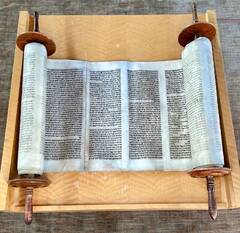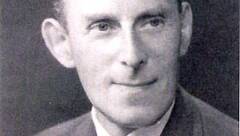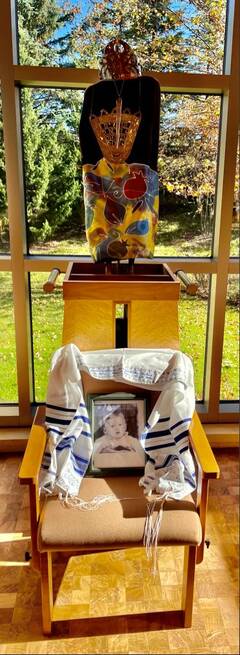Memorial Scrolls Trust - Page 1
Czech Torah Scroll #942 - Memorial Scrolls Trust

This Torah Scroll, Memorial Scrolls Trust (MST) #942, entrusted to Congregation Emanu-El B’ne Jeshurun (CEEBJ), was written in Bohemia/Moravia around the year 1800.  It was one of 115 at the Pinkas Synagogue in Prague, now in the Czech Republic, many of which were sent there from nearby synagogues in 1939 for safe-keeping.
It was one of 115 at the Pinkas Synagogue in Prague, now in the Czech Republic, many of which were sent there from nearby synagogues in 1939 for safe-keeping.
The Torah is one of 1,564 gathered from Bohemia and Moravia, and then brought to the Central Jewish Museum between 1942 and 1944. It is a mystery as to why the Germans agreed for these and 200,000 other items to be sent from some 130 towns, filling over 30 buildings. For many years, it was believed the Nazis had a plan to create a Museum of an Extinct Race after the war, but this is now believed to be a myth.
 In 1963, this group of Sifre Torah and other scrolls was purchased from the Czech government in Prague by Mr. Ralph Yablon. In 1964, he donated them along with some 500 binders/wimples to the Westminster Synagogue in London. Those that were kosher or restorable were allocated on permanent loan to synagogues and organizations around the world. Torah Scroll #942 was initially repaired by the Memorial Scrolls Trust, a UK Charity, that continues to maintain responsibility for them.
In 1963, this group of Sifre Torah and other scrolls was purchased from the Czech government in Prague by Mr. Ralph Yablon. In 1964, he donated them along with some 500 binders/wimples to the Westminster Synagogue in London. Those that were kosher or restorable were allocated on permanent loan to synagogues and organizations around the world. Torah Scroll #942 was initially repaired by the Memorial Scrolls Trust, a UK Charity, that continues to maintain responsibility for them.
In 1967, Rabbi Dudley Weinberg (z”l) of CEEBJ arranged to have Torah Scroll #942 sent to our synagogue. Synagogue member Sarah Surlow Zucker (z”l) generously provided a gift to CEEBJ for the costs of transporting and restoring the Torah in memory of her husband Leo. The Torah’s arrival from England was celebrated by the Zucker Family and the congregation by dancing with it on Simchat Torah. It was also used at CEEBJ at the b’nei mitzvah of several of Sarah Zucker’s grandchildren. Click here for the story of Sarah’s desire to restore this Torah.
Description of Torah Scroll MST #942
 Torah Scroll MST #942 was written at the end of the 18th century or in the very early 19th century, in Bohemia/Moravia. A thorough assessment of the Torah’s condition was conducted in 2015 by Sofer Rabbi Kevin Hale of Leeds, Massachusetts. Rabbi Hale, certified as a sofer by the Holocaust Memorial Trust, is an expert in Torah restoration. He reported that this Torah is written on fine, thin parchment. The style of sewing of yeriot (panels), with each edge folded back (rather than one unfolded edge slid behind on the folded edge), and the oxidation of the reddish-brown letters, originally black (as required by halahah (Jewish law)) all suggest a date of 1800 at the latest.
Torah Scroll MST #942 was written at the end of the 18th century or in the very early 19th century, in Bohemia/Moravia. A thorough assessment of the Torah’s condition was conducted in 2015 by Sofer Rabbi Kevin Hale of Leeds, Massachusetts. Rabbi Hale, certified as a sofer by the Holocaust Memorial Trust, is an expert in Torah restoration. He reported that this Torah is written on fine, thin parchment. The style of sewing of yeriot (panels), with each edge folded back (rather than one unfolded edge slid behind on the folded edge), and the oxidation of the reddish-brown letters, originally black (as required by halahah (Jewish law)) all suggest a date of 1800 at the latest.
He noted that the scroll is similar to many MST scrolls that have kabbalistic elements (such as large and small letters, right-hand indentations, single line-breaks, and embellished or ornamented letters), although these are absent from this scroll. Each column contains 42 lines, which became standard only circa 1850, long after this scroll was written.
Restoration of the Torah in 2015
Restoration of the Torah began in early 2015 when the scroll was sent to Sofer Rabbi Kevin Hale. Rabbi Hale assessed the Torah’s condition and created a plan for the restoration needed. For more information about the restoration process, click here.
Rededication of The Torah in 2015
The rededication event, held November 15, 2015, brought together CEEBJ members of all ages, the Zucker family and several Holocaust survivors. For more information about this event, click here.
How Torah Scroll MST #942 is Used at CEEBJ Today
This Torah has a place of honor in the ark in the CEEBJ Sanctuary. It is taken from the ark as part of a congregational tradition annually for Kol Nidre. All the Sifre Torah are removed from the ark just before Kol Nidre is to begin. As Kol Nidre is chanted, each Torah is held by the current congregational president or one of the former presidents while standing on the bimah facing the congregation.
This Torah Scroll is also removed from the ark annually at Simhat Torah and carried as part of the celebration. Torah Scroll MST #942 is pictured here in the bottom row on the right, along with our other Sifre Torah. To help preserve the Torah because it is fragile due to age and wear, we only occasio nally read from this Torah. It was a special moment when Sarah Zucker’s great-granddaughter read from the Torah as she became a Bat Mitzvah.
nally read from this Torah. It was a special moment when Sarah Zucker’s great-granddaughter read from the Torah as she became a Bat Mitzvah.
The Czech Holocaust Torah Scroll is regularly used as part of b’nei mitzvah services at CEEBJ. The Twinning Program is a touching tradition many CEEBJ families include in the b’nei mitzvah service. With the Director of Lifelong Learning, each child explores the data base of the Yad Vashem Holocaust Museum in Jerusalem to identify a child who perished in the Holocaust and honor the child’s memory during the service. The bar/bat mitzvah may choose to select a child who lived in the same country or community as a family member who emigrated to the U.S. or had a name similar to that of the bar or bat mitzvah child.
At the ser vice itself, this Torah Scroll is removed from the ark and placed in one of the Torah stands on the bimah for the remainder of the service. This Torah thus represents the child who is being remembered. The bar or bat mitzvah explains why they have chosen to participate in the Twinning Program. The selected child who perished in the Holocaust is identified by name as the bar or bat mitzvah shares information about them from the Museum’s data base. The bar/bat mitzvah expresses gratitude at becoming bar or bat mitzvah as they honor the memory of the child they selected.
vice itself, this Torah Scroll is removed from the ark and placed in one of the Torah stands on the bimah for the remainder of the service. This Torah thus represents the child who is being remembered. The bar or bat mitzvah explains why they have chosen to participate in the Twinning Program. The selected child who perished in the Holocaust is identified by name as the bar or bat mitzvah shares information about them from the Museum’s data base. The bar/bat mitzvah expresses gratitude at becoming bar or bat mitzvah as they honor the memory of the child they selected.
|
Memorial Scrolls Trust Information To learn more about the Memorial Scrolls Trust and to view the locations and information about other MST Sifre Torah throughout the world, visit MemorialScrollsTrust.org. |
Thu, November 6 2025
15 Cheshvan 5786
Today's CEEBJ News
► List your name in the Directory brought to you by Temple Brotherhood. Click here to make your sponsorship donation.
► Summer camp scholarships are available for children through 12th grade. Click here to apply.
►The Annual Deli Dinner brought to you by Temple Brotherood will be Sunday, Nov. 9. It's a real delicatessen experience. Click here to register.
► How well did we meet your needs this fall holiday season? Please take our latest MitzVote poll and tell us what you appreciated and what you would like us to consider doing differently next year.
► Make your 2025-26 Annual Commitment.
Featured Events
-
Thursday ,
NovNovember 6 , 2025Strings of Memory and Hope: Jewish Lessons from Violins of Hope
Thursday, Nov 6th 7:00p to 8:30p
-
Friday ,
NovNovember 7 , 2025Shabbat Service
Friday, Nov 7th 6:00p to 7:15p
-
Sunday ,
NovNovember 9 , 2025Torah Tots
Sunday, Nov 9th 9:30a to 10:30a
-
Sunday ,
NovNovember 9 , 2025Brotherhood Deli Dinner
Sunday, Nov 9th 5:00p to 8:00p
-
Monday ,
NovNovember 10 , 2025Understanding the Siddur, Part II
Monday, Nov 10th 10:30a to 11:30a
-
Tuesday ,
NovNovember 11 , 2025Women's Torah Study
Tuesday, Nov 11th 10:00a to 11:30a
Join Our Mailing List
Congregation Emanu-El B'ne Jeshurun * 2020 West Brown Deer Road, River Hills, WI 53217 * (414)228-7545
Privacy Settings | Privacy Policy | Member Terms
©2025 All rights reserved. Find out more about ShulCloud
